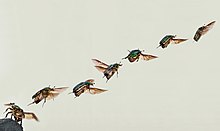Movement

Movement, or motion, is the state of changing something's position or changing where something is. A bird that is flying is moving. So is a person who is walking. This is, because they change where they are. They "move" from one place to another. There are many forms of science and mathematics that are related to movement.
Because of the work of scientists including Galilei and Newton, we know that position is relative. This means that an object's position depends on where it exists in relation to other objects. For example, a ball can be 5 ft (150 cm) away from a box, 3 ft (91 cm) from a chair and 1 ft (30 cm)away from a table. Here, the box, chair and the table helped to define the position of the ball. They acted as the reference points for the observation of the ball. By telling someone how far the ball was from other objects, they were told its relative position.
The motion of an object is also relative. It depends on how its position changes in relation to other objects. For example:
A person is sitting inside a train (Train A). The train has not started moving yet. When that person looks out the window, they see another train (Train B) . Both trains are facing the same direction. If Train B moves backwards, it appears to the person on Train A that they are moving toward Train B. If a reference point it added this can be changed. If the person can also see a pole next to the trains they will see that train A did not move and train B moved backwards.
From this, it is shown that what the movement is can not bo known without a frame of reference. In this example the pole is the frame of reference.
The study of motion without considering its cause is called kinematics. Kinematics deals with terms like speed, velocity, and acceleration. Dynamics is the branch of physics that focuses on the causes and effects of motion. It deals with force, inertia, work, energy and momentum.
Animal movement[change | change source]
The movement of animals is controlled by the nervous system, especially the brain and spinal cord.
The muscles that control the eye are driven by the optic tectum in the midbrain. All the voluntary muscles in the body are controlled by motor neurons in the spinal cord and hindbrain.[1] Spinal motor neurons are controlled by neural circuits of the spinal cord, and by inputs from the brain. The spinal circuits do many reflex responses, and also do rhythmic movements such as walking or swimming. The descending connections from the brain give more sophisticated control.[1]
The brain has several areas that project directly to the spinal cord. At the highest level is the primary motor cortex. This is a strip of tissue at the back of the frontal lobe. This tissue sends a massive projection directly to the spinal cord, through the pyramidal tract. This allows for precise voluntary control of the fine details of movements. There are other brain areas which affect movement. Among the most important secondary areas are the premotor cortex, basal ganglia, and cerebellum.[1]
| Area | Location | Function |
|---|---|---|
| Ventral horn | Spinal cord | Contains motor neurons that directly activate muscles[2] |
| Oculomotor nuclei | Midbrain | Contains motor neurons that directly activate the eye muscles[3] |
| Cerebellum | Hindbrain | Calibrates precision and timing of movements[1] |
| Basal ganglia | Forebrain | Action selection on the basis of motivation[4] |
| Motor cortex | Frontal lobe | Direct cortical activation of spinal motor circuits |
| Premotor cortex | Frontal lobe | Groups elementary movements into coordinated patterns[1] |
| Supplementary motor area | Frontal lobe | Sequences movements into temporal patterns[5] |
| Prefrontal cortex | Frontal lobe | Planning and other executive functions[6] |
In addition, the brain and spinal cord controls the autonomic nervous system. this system works by secreting hormones and by modulating the "smooth" muscles of the gut.[1] The autonomic nervous system affects heart rate, digestion, respiration rate, salivation, perspiration, urination, sexual arousal and several other processes. Most of its functions are not under direct voluntary control. Several of them, such as respiration, can be controlled directly as well.
Related pages[change | change source]
References[change | change source]
- ↑ 1.0 1.1 1.2 1.3 1.4 1.5 Kandel, Eric R; Schwartz, James Harris & Jessell, Thomas M. 2000. Principles of neural science. New York: McGraw-Hill. ISBN 978-0-8385-7701-1 []
- ↑ Dafny, N. "Anatomy of the spinal cord". Neuroscience Online. Archived from the original on 2011-10-08. Retrieved 2011-10-10.
- ↑ Dragoi, V. "Ocular motor system". Neuroscience Online. Archived from the original on 2011-11-17. Retrieved 2011-10-10.
- ↑ Gurney, K; Prescott, TJ; Wickens, JR; Redgrave, P (2004). "Computational models of the basal ganglia: from robots to membranes". Trends in Neurosciences. 27 (8): 453–459. doi:10.1016/j.tins.2004.06.003. PMID 15271492. S2CID 2148363.
- ↑ Shima, K; Tanji, J (1998). "Both supplementary and presupplementary motor areas are crucial for the temporal organization of multiple movements". Journal of Neurophysiology. 80 (6): 3247–3260. doi:10.1152/jn.1998.80.6.3247. PMID 9862919.
- ↑ Miller, EK; Cohen, JD (2001). "An integrative theory of prefrontal cortex function". Annual Review of Neuroscience. 24 (1): 167–202. doi:10.1146/annurev.neuro.24.1.167. PMID 11283309.
